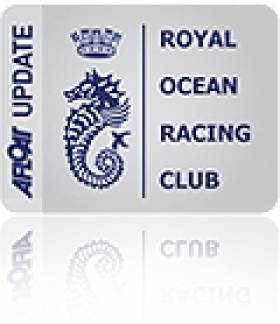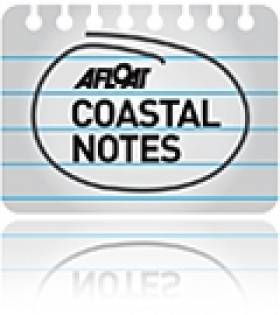Displaying items by tag: Channel
Hydrofoil Dinghy Sailor Breaks Cross Channel Record
#channelrecord – Hannah White has become the fastest person to cross the Channel in a single-handed dinghy. She completed the gruelling task in a sailing hydrofoil, a small boat which lifts above the water on two hydrofoils as it gathers speed. Starting from Cap de Gris in France, she arrived at Dover in England in a record time of 3 hours, 44 minutes and 39 seconds.
Hannah, a relative beginner in hydrofoil sailing, only started to learn how to master this unique boat in February. Training for this Channel crossing challenge is a precursor to her ultimate quest: to break the Women's Speed Sailing World Record over one nautical mile next year in a unique, purpose-built sailing hydrofoil.
A keen adventurer, Hannah has previously sailed the Atlantic solo three times, participated in the gruelling Haute Route Cycle Race across the French Alps and kayaked 205 miles across the rivers of England. She has been a Land Rover Global Ambassador since 2013.
Hannah White said: "I'm much more used to an arduous 3000-mile slog across oceans as opposed to a 24-mile sprint across the Channel, so the transition has been a real eye-opener. Speed sailing requires a very different physiology to long distance races, so this was really an opportunity for me to build my skills over a shorter distance in a hydrofoiling boat."
Mark Cameron, Jaguar Land Rover Global Experiential Marketing Director, said: "This Channel crossing highlights Hannah's incredible ability to push herself beyond the limits of normal capability. As a global ambassador for Land Rover, Hannah embodies all the characteristics that are so central to our brand; strength, determination and an ability to go above and beyond."
Hannah will be attempting to break the Women's Speed Sailing Record over one nautical mile in the first quarter of 2016 in Speedbird, her state-of-the-art, unique hydrofoil sailboat. Land Rover is collaborating in the development of the Speedbird boat, drawing from its unparalleled innovation, engineering expertise and industry-leading facilitiesto ensure the boat is capable of breaking the current world record.
Hannah will be exhibiting the Speedbird boat at the Cardiff Act of the Extreme Sailing SeriesTM on the 19-21 June 2015.
Fickle Winds Prevail for RORC Channel Race
The leg to St Catherine's was painful and as the new breeze filled in from the South West it was those who were offshore that benefitted. There were several retirements but those that stuck it out were rewarded with some excellent sailing in a moderate breeze once they got to Bembridge Ledge.
The shy reach east to Saltdean Light Buoy (off Brighton) favoured the yachts carrying asymmetric spinnakers and by the time the fleet finished back in the Solent it was a glorious day with fair winds for a wonderful finale to the race.
David Aisher's J/109, Yeoman of Wight, crewed by the British Keelboat Academy were the overall winners in a large fleet taking the Channel Challenge Cup.
Yeoman of Wight's skipper, Henry Smith described the important factors in their win. "We got through Hurst in good shape. Leading our class, because we decided to go to the main land shore, which worked very well for us. Like the rest of the fleet, when the wind died we ended up kedging at Bridge.
However for most of the race we had a spinnaker up and we were very meticulous about our watch system, making sure that we all stayed as fresh as possible, especially alternating trimmers and minimising disruption during hand overs by talking through the conditions as new crew came up on deck. We approached Saltdean Light Buoy with favourable tide and as we went around the tide turned in our favour and we knew we were in with a chance. It was a great team effort and we are absolutely delighted with our win."
" I am very proud of their achievement" commented David Aisher. "The average age of the team is just twenty one, and this is a great boost to their confidence before the Rolex Fastnet Race, which is just a few weeks away."
In IRC Zero, Johnny Vincent's TP 52, Pace, scored a notable victory over IRC Zero RORC Season's Points Leader Venomous, skippered by Derek Saunders and Andres Soriano's Mills 68, Alegre.
In IRC One, Mark Devereux's Swan 42, Brevity, claimed their first class win of the season beating the current RORC Season's Points Championship leader Piet Vroon's Tonnerre de Breskens. Jonathan Goring's Ker 40, Keronimo, was third in class.
IRC Two produced a titanic battle between two J/122s, Neil Kipling's Joopster, and Alain Catherineau's Lorelei. Joopster won class by just under three minutes on corrected time. Quokka 8, sailed by Sailing Logic, took line honours for the class and was just five minutes short of eclipsing the winner after time correction.
IRC Three was won by Yeoman of Wight, second was Tor McLaren's J/109, Inspara, with Peter Olden's A 35, Solan Goose of Hamble, third.
IRC Four saw a clean sweep of podium places for French yachts. Nicolas de la Fourniere's X-34, Exile/Mirabaud, was first in both IRC Four and the Two-Handed Class. Frederic Waniart's Aphrodite 101, Vim, and Pierre Viard's Prism 28, Adrenaline, were second and third in IRC Four, respectively.
"What a difference a day makes" commented RORC Racing Manager, Ian Loffhagen. "Before the start drizzle and the fickle wind was not conducive to great racing but as forecast the breeze did fill in and those yachts that stuck it out enjoyed a great race in some beautiful conditions. The race took most of the yachts about 24 hours as planned and more importantly, fulfilled several yachts ambitions of completing the necessary qualifying miles for the Rolex Fastnet Race. I am sure that the competitors and also all of us at the RORC are now fully focused on the highlight of the season."
The Rolex Fastnet Race starts on August 14th, competitors are advised that decals, trackers and Sailing Instructions are now available from the RORC Office in Cowes, however these will only be issued to yachts that have completed all of the entry requirements.
A Southern Expedition Claims 'new found land' in Needles Channel
Thanks to a rare natural occurrence, the Shingles bank forms the Western edge of the Needles Channel and has been synonymous with navigational blunders over the years. Yesterday three RIBs (rigid inflatable boats) set out from Hamble in search of new lands, thanks to the lowest tide of the year and an ever-changing shingle bank. Low tide revealed a truly impressive sight, rising out of the sea.
Upon landing at 16:12, a pennant was planted upon the highest point, in lunar-landing style. One small step for man, one giant leap for yachtsmen. A veritable feast was prepared ashore and a glass raised on what was a truly memorable evening. The explorers departed at 1810 under the last rays of the sun.
Plans are being put in place to make this an annual event, conditions allowing. The Royal Southern has a history of unusual antics at low tide including hosting the annual Brambles Bank Cricket Match with the Island Sailing Club in the middle of the Solent.































































